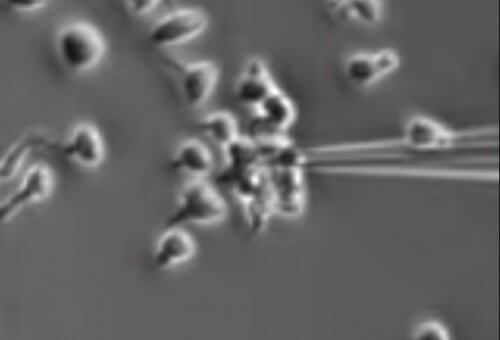In the framework of two new studies, scientists are answering the age-old questions regarding how complex cells sense the chemical trail that directs them to their destination, and regarding the role of the cell's internal structure in response to these cues.

[Translation by Dr. Nachmani Moshe]
Amoebae are not the only cells capable of movement - movement is an essential feature for development, wound healing and the proper activity of the immune system in any disease, and also, unfortunately, for the spread of a cancerous tumor.
In the framework of two new studies, scientists are answering the age-old questions regarding how complex cells sense the chemical trail that directs them to their destination, and regarding the role of the cell's internal structure in response to these cues.
Thanks to these chemical trails, the cells navigate themselves based on tiny differences in the concentrations of the chemicals found between the ends of one cell and the other. "Cells can detect concentration differences at extremely low rates of 2%," says Peter Devreotes, director of the Department of Cell Biology at the Johns Hopkins University School of Medicine. "The cells are also versatile in that they detect tiny differences even when the environmental concentration is very high, very low or in between."
The researchers developed a system that allows viewing the reaction of a cellular control center that directs the movement. In the next step, they introduced amoebae and human white blood cells into cascades of varying concentrations and examined what was happening. "It turned out that examining the concentration cascades is a two-stage process," said the researcher. "First, the cell tunes out the background noise so that the side of the cell exposed to the smaller amount of the chemical signal stops responding to it. In the next step, the control center inside the cell increases its response to the message that reaches it from the other side of the cell and causes the cell to start moving towards the signal." The research findings were published in the scientific journal Nature Communications.
However, in order to start and move in a defined direction, the cell must first of all reorganize the internal structures within it so that its shape is no longer a uniform spherical eye, but as a body with distinct and distinct sides of a head and tail, this according to further research. This study examined the role of the property known as polarization - differences in sensitivity to chemicals between the front and back side of the cell - in response to the concentration cascade. In previous studies, the scientists added a drug that completely dismantled the cytoskeleton and thus prevented its ability to move. They found that these cells also lost their polarization. "We wanted to know if the polarization depends on the movement and if the polarization itself - independent of the movement - helps in identifying the concentration cascades."
The research team used a mixture of materials that, instead of breaking down the cell skeleton, freezes it in place. In the next step, they observed the response of the cellular control center when exposed to cascades of chemical concentrations. "Despite the fact that the cells were unable to reorganize their skeleton in order to move, they were able to receive signals from the cascades and the response to the cascade was affected by the frozen skeleton," notes the lead researcher. "This does not occur if the skeleton completely disintegrates, so we know that the skeleton itself, and not necessarily its ability to reorganize itself, is what affects the identification of the falls." The findings of this second study appeared in the scientific journal Cell Reports.
Thanks to the discovery of the details regarding the movement of cells, the findings could, in the end, reveal many vital processes that depend on this type of movement, including development, the immune response, wound healing and organ regeneration, and even offer new ways to treat the spread of cancerous tumors.
